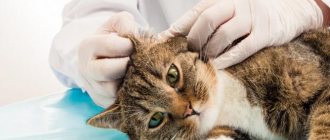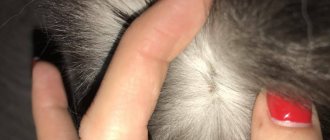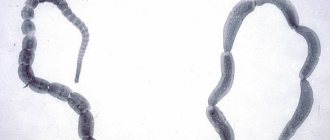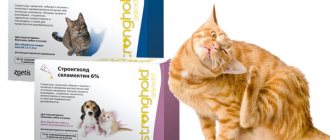A cat is a favorite of the whole family, it brings comfort to our home, gives its owners warmth and joy. For his part, a person must take care of the animal and monitor its health. The main problem that cat owners face is the diseases of their pets, as well as various parasites that often bother them. Fleas are the most common parasite on cats, especially when it comes to animals that walk outside. These require immediate and decisive action on the part of the owner because they seriously undermine their health. These parasites can be carriers of dangerous diseases and pose a danger to humans. They do not live on it, but can feed on its blood through bites.
You can remove fleas from a cat at home, but you should first show the animal to a veterinarian. These pests lead to serious weakening of the animal, in advanced cases it causes anemia, weakens the immune system, which can cause other, more serious diseases. That is why any cat owner should know the first signs of these insects, as well as how to get rid of them.
Cat flea: who is it and where does it come from?
To understand where cats get fleas from, you should learn more about these parasites: their structure, feeding habits, and life cycle. Fleas are a huge order of wingless insects that are blood-sucking exoparasites and parasitize on any animal. They have a rather narrow specialization: there are fleas of rabbits (Spilopsyllus cuniculi), dogs (Ctenocephalus canis), humans (Pulex irritans) and cats (Ctenocephalides felis). These insects also parasitize rats and birds. Outwardly, they are very similar; only a professional entomologist can determine the exact type of insect.
general description
What does a flea look like on a cat? Their body size ranges from 1 to 5 mm, the cat flea reaches approximately 2 mm. Males are smaller than females. The parasite that has sucked blood increases sharply in size—approximately 2 times. The insect's body is flattened laterally (this makes it easy to move between hairs) and covered with numerous spines and bristles. They help the insect to stay between the hairs of fur or feathers.
The oral apparatus of the parasite is of the piercing-sucking type, which includes a special stylet that pierces the skin of the host. They do not have a proboscis. The limbs of the parasite are strong, they give it the ability to move along surfaces at any angle, as well as make long jumps. The abdomen has special tactile hairs that are sensitive to air vibrations.
They are wingless insects - with their lifestyle, wings would only get in the way of the parasite. The shape of the body and the chitinous cover make mechanical damage to the insect very difficult - it cannot be crushed with your fingers. The parasite can only be destroyed by crushing it with a fingernail on a hard surface.
This is interesting! Fleas are one of the best jumpers in the animal kingdom. Having a size of only a few millimeters, they can jump 19 cm in height and 30 cm in length. This is a hundred times the size of their own body. A person, in order to repeat these results, must long jump 160 meters.
Life cycle
Fleas are insects with a full life cycle; they have the stages of adult insect, egg, larvae and pupae. The female lays her eggs anywhere, and after about two weeks a worm-like larva appears, which grows and molts several times. The larvae live in dust and debris, feeding on decaying organic matter and excrement.
Later, the larva pupates and after a while emerges from the pupa as an adult insect. Now she just needs to find her owner.
The insect's lifespan is approximately 2 years. Parasites reproduce very actively; during her life, the female lays up to 2 thousand eggs.
Cat fleas can also spread to rats, and they displace the rat flea.
Eating habits
Each type of parasite prefers its own host. They adapt to a certain skin structure, its temperature, the composition of the host’s blood and other characteristics. They can feed on the blood of other animals, but they do not do this very willingly.
Although, it should be noted that in this regard the cat flea is the most picky, as it can easily drink both dog and human blood. She is the champion in the number of bites to people.
Typically, these insects do not live permanently on their host. Rather, it serves as their dining room. They attack him from time to time, drink his blood and leave again. They live near their owner. There are some types of fleas that live permanently on their host; these are parasites of nomadic animals.
They feed daily, but can easily endure several months of fasting, after which they pounce on food with particular greed.
This is interesting! Fleas have changed little over the past 50 million years. The fossil insects that scientists studied are almost no different from modern ones. Evolution, apparently, considered that it had already created a masterpiece, which did not make sense to change.
Diseases
Fleas are carriers of serious diseases in humans and domestic animals. Rat pests are especially dangerous. They carry plague, typhus and other serious diseases. In the Middle Ages, entire cities died out from plague epidemics transmitted by rats.
Fortunately, the cat flea does not carry such dangerous diseases, but other types of these insects can live on your pet.
Traditional methods
You can get rid of fleas on a kitten at home without the use of special chemicals. This is especially true if the baby is less than 2 months old. Traditional methods are gentle and harmless, but sometimes tedious and not effective enough. But if you have no choice, it's worth trying them. How to remove fleas from a kitten using traditional methods: manually or using natural remedies.
Mechanical removal
By rights, the safest method of getting rid of fleas is mechanical, which allows you to remove insects even from newborn kittens. At the same time, it is the most labor-intensive and time-consuming, since it is not possible to quickly get rid of fleas by combing due to the presence of numerous clutches of eggs.
To carry out the procedure, you will need a hard plastic comb with frequent rounded teeth and a white sheet of paper. Combing fleas should begin from the back, gradually moving to the abdomen and paws. It is not recommended to manipulate the pet's head - you can injure the kitten's ears, nose and eyes. Any fleas on the paper should be immediately crushed or thrown into a container of water. The processing comb also needs to be periodically cleaned of accumulations of insects and hair.
You need to carry out the procedure twice a day until the fleas disappear. One combing session should take about 10 minutes on average. As a rule, it takes 1 month to solve the problem. Afterwards, it is necessary to check the fur for several weeks, since new individuals could emerge from the remaining eggs.
Bathing
Plain water will not get rid of fleas. But if you add salt, tansy or wormwood to the bath, the insects will begin to disappear.
Salt bath. Add table salt to warm water at the rate of 1 tbsp. 200 ml, dissolve. Place your pet in the solution for 10 minutes. Then pat the fur dry with a towel and comb out with a comb. Repeat the procedure every week.
A decoction of wormwood or tansy. Brew the chopped herb in boiling water (1 tablespoon per glass). Prepare a warm bath and pour in the infusion. Keep your pet in the solution for several minutes and dry the fur well. The procedure can be carried out several times a week.
Where do fleas come from on a domestic cat?
The most careful care of your pet, even if it does not go outside, is not a 100% guarantee that your pet will not have parasites. People often ask how a domestic cat got fleas if it has never left the premises or interacted with outdoor animals. In fact, the transfer of parasites from one animal to another is just one way of infection. There are several of them:
- walking on land infested with flea eggs;
- contact with an infected animal;
- brought into the house by a person (most often these are insect eggs, but there may also be adults).
Therefore, a pet can easily pick up these ubiquitous parasites. If your pet walks outside, then the probability of infection is almost 100%.
Up to 200 insects can live on one animal at the same time.
How do they reproduce?
On cats, these insects reproduce very quickly, and only a few days are enough for the animal to be completely “occupied” by reptiles .
Like all blood-sucking creatures of this type, fleas lay small eggs on the animal’s hair.
It is worth mentioning that eggs can only be laid by a well-fed female who has been parasitizing the pet for some time. The clutch can be of different sizes: it all depends on the conditions, the condition of the parasite and the environment.
Detecting eggs is quite difficult : this will require special equipment, because the size of future parasites is very small.
After 1-4 days, pupae hatch from the eggs, which develop into worms that feed on the skin of the animal, excrement of mature individuals, litter, etc. After 1 - 3 weeks, the pupa turns into a full-fledged individual, which can be seen on the cat.
Study the article about flea drops for cats, as well as reviews of some brands: Stronghold, Advocate, Advantage, Inspector, Bars, Frontline.
How to tell if a cat has fleas
How to determine if a cat has fleas? This is one of the most frequently asked questions on this topic. It is quite simple to identify parasites on an animal’s body; there are characteristic signs of this disease that are hard to miss:
- The pet not only itches, but violently bites into the fur, which it does especially often.
- The animal is restless and very nervous. Insects cause severe itching, depriving them of their usual rest. Often meows pitifully, trying to attract your attention.
- When scratching, you can see brown lumps - these are parasite excrement.
- Also, when combing, the parasites themselves are visible.
The disease is conventionally divided into several stages. Immediately after infection (the first stage), the animal’s behavior is not much different from usual - the cat eats normally and is playful. Visually detecting parasites is almost impossible because there are very few of them.
The only symptom that may indicate that pest infestation has occurred is your pet's frequent scratching.
At the second stage of infection, the animal’s behavior changes greatly: it begins to get nervous, sleeps poorly, constantly itches and tries to gnaw out pests with its teeth. Scratches and wounds appear on the body. At this stage, parasites can be easily detected visually.
If measures are not taken immediately, the disease will progress. Your affectionate, sociable and cheerful cat will turn into a gloomy and downtrodden animal. In addition, infection in an advanced stage has unpleasant health consequences:
- the animal loses weight and becomes weaker;
- stops playing;
- the fur falls out in clumps;
- Frequent vomiting may begin;
- various dermatitis develops.
It can be added that in caring owners, the infection does not reach the third stage. It is difficult not to notice parasites already at the second stage of the disease, and the means that exist now (this will be discussed in detail below) allow you to effectively and fairly quickly get rid of these insects.
The most favorite places for fleas to live on a cat’s body are the stomach, neck area and the jaw area. It should be remembered that they are not the only parasites that can appear on your pet. There are also lice eaters, but they are usually located on the fur, and fleas prefer the skin of the animal.
Danger of ectoparasites
In addition to the serious discomfort that blood-sucking insects living in its fur cause a cat, fleas pose a great danger. They are carriers of a huge number of dangerous diseases. Some of them can be fatal. A number of diseases carried by fleas are dangerous not only for animals, but also for humans.
Fleas carry:
- the causative agent of yersiniosis - an acute intestinal infection accompanied by a toxic-allergic reaction;
- bacteria that cause Far Eastern scarlet fever (pseudotuberculosis);
- plague stick;
- causative agent of hemorrhagic septicemia (pasteurellosis);
- bacteria that cause intestinal infection salmonellosis;
- Brucella;
- bacteria that cause tularemia;
- rickettsia;
- hepatitis viruses type B and C, tick-borne encephalitis;
- Trypanosomes are protozoan parasites that cause a number of diseases in humans and animals.
In addition, fleas are carriers of helminth eggs. If a cat has a lot of fleas and has been infected with them for a long time, then there is no doubt that she has endoparasites (for example, cucumber tapeworms).
The presence of fleas in a pet leads to a decrease in its immunity and causes various allergic reactions. Also, the appearance of ectoparasites leads to an exacerbation of chronic diseases, if the cat has any. Due to severe itching, the animal constantly scratches its skin, sores and wounds form on the body. They can fester, which will seriously complicate the pet’s condition.
In addition, constantly scratched wounds are a gateway for various pathogenic microorganisms to enter the cat’s blood.
If no measures are taken, a flea-covered cat will develop dermatological diseases of varying severity: dermatitis, dermatoses, eczema, allergic rashes. Her fur may start to come out. In some cases, if treatment is delayed, bald spots may persist forever.
In addition, constant itching and discomfort caused by insects adversely affect the emotional state of the cat. She becomes restless, nervous, cannot sleep normally, and constantly meows.
If a kitten gets fleas, then ectoparasites can cause very serious damage to the body, even death.
In humans, cat flea bites cause allergic skin reactions, itching, swelling and irritation of the skin. Fleas can infect it with infectious diseases they carry, and also cause helminthic infestation.
Why are cat fleas dangerous?
Infection with them is dangerous not only because of the deterioration of your pet’s general condition; there are also other reasons why you should rid your animal of these parasites as quickly as possible. These are diseases that are transmitted by fleas and can be dangerous for both the cat and its owners.
Danger for cats
In addition to a noticeable deterioration in physical and mental condition, fleas very often cause allergic dermatitis. Also, these insects are carriers of helminths. To date, it has been proven that these parasites are intermediate hosts of several dozen species of worms. The larvae feed on worm eggs, and they are also stored inside the adult insect. A cat may well become infected with helminths by biting into insects.
Fleas are carriers of infectious anemia - hemobartonellosis, which leads to a decrease in red blood cells in the animal's blood. They also carry dangerous fungal and viral diseases. Among them are mycoplasmosis - it affects various organs, as well as rickettsiosis - a disease characterized by a febrile state of the animal.
Severe infestation with them can lead to complete or partial baldness of the pet - the lost hair will never grow back. In addition, your pet may develop serious mental problems.
Danger for kittens, pregnant and lactating cats
Fleas pose an even greater danger to kittens. A fragile body is not able to fight parasites, so they often cause their death. Flea infestation in kittens leads to the following consequences:
- rapid weight loss and cessation of growth;
- the occurrence of anemia.
It is this disease that most often causes the death of an animal.
Parasites are also dangerous for pregnant cats. They deprive them of nutrients and weaken the animal. There is one more point - many of the anti-flea drugs are toxic. Their entry into the body of a pregnant woman can negatively affect the offspring. The situation is similar with feeding animals. Veterinarians advise to carry out the destruction of parasites before future mating, so you can avoid the harmful effects of parasites and medications.
Danger to humans
Cat fleas also bite humans, although they do so reluctantly and quite rarely. As mentioned above, these insects have a rather narrow specialization and prefer to feed on the blood of one host. Bites are fraught with both minor troubles and serious consequences, in the form of dangerous diseases carried by parasites.
When bitten, the parasite injects an anesthetic and an anticoagulant into the victim's body, which prevents blood clotting. Both of these proteins are foreign to us, and the human immune system instantly reacts to this - an allergic reaction begins (itching, burning, inflammation). Multiple bites disfigure the skin, it becomes covered with wounds and scratches. The legs suffer the most; the insect can jump up to about a person’s knee.
There is another danger - diseases that fleas carry:
- pulicosis;
- massive dermatitis;
- dipylidosis;
- brucellosis;
- creeping erythema;
- anthrax.
Are cat parasites transmitted to humans?
Many pet owners wonder whether cat parasites can spread to humans.
The cat flea is not very fond of human skin, although it bites when there is no other “victim” nearby. It will not live or reproduce on the body, since the temperature in humans is lower than that needed by the insect for metabolism and normal existence. And the cat’s temperature is approximately 38–39 °C, which is very comfortable for a flea. The difference in temperature is quite large, and we also have thicker skin than a pet.
Thus, the question of whether parasites are transmitted from cats to humans can be answered in the negative. But sometimes insects cause trouble: the bitten areas are very itchy.
How to get rid of fleas on a cat
Those faced with this scourge ask questions:
How to kill fleas on a cat and what to use to get them out?
What methods and drugs are the most effective and least harmful to the health of the animal?
It is also important to know how to completely expel fleas from your home. As mentioned above, parasites do not live permanently on an animal, they use it only for food, and they usually live and reproduce somewhere nearby.
Treatment of fleas in cats
Today, there are a large number of methods and means that allow you to cure a cat very quickly and effectively. Here are the main ones:
Drops - applied to the animal’s withers, are very effective and allow you to quickly solve the problem. They have a residual effect. Their main disadvantage is the likelihood of developing allergies.
Sprays are a fairly effective remedy that can cure in a short period of time. They act effectively, have no residual effect, but rarely cause allergies.
Shampoos are the most gentle and effective remedy for fleas in cats, however, they are not so easy to use (bathing some cats is very difficult). When using shampoo, be careful not to get the product into the animal's eyes.
A collar is more about preventing fleas in cats than treating them. It is better to use it after applying the methods described above. It is especially relevant for pets that go outside. In addition to protecting against parasites, it shows workers of special services that the animal is not homeless, but has an owner.
There are also tablets and powders against these insects, but they are less convenient to use. It is quite possible to remove fleas from a cat at home, but before treating your pet it is better to consult a veterinarian.
Removing parasites indoors
It is not enough to get rid of parasites on the animal itself; they should also be destroyed in the premises.
First of all, you need to take care of the place where the animal lives - the bedding needs to be changed or boiled. Then, you should treat all surfaces in the apartment on which adult parasites, their eggs and larvae may remain.
The premises are cleaned using special products that can be purchased at a veterinary pharmacy.
Review of effective remedies
It is not always possible to independently select a suitable flea drug in the form of drops, since their range is quite extensive. Analyzing information from manufacturers, reviews, and the opinions of veterinarians, we can identify several popular brands that meet the criteria of safety and effectiveness.
Foreign manufacturers
- Hartz. American-made drops destroy flea larvae and oviposition. They should not be used on kittens under three months of age. Apply the product to the occipital area. The effect of the drug lasts for a month, after which the procedure is repeated. The protective effect is not reduced by short-term exposure to moisture. A preliminary consultation with a veterinarian will be required regarding the use of drops for pregnant cats, aging, and sick animals.
- Beaphar. In the line of Dutch-made flea drops, you can choose varieties for kittens and adult cats, including weakened and pregnant ones. The active ingredient is a natural margosa extract that is safe for animals. Convenient packaging in disposable ampoules is offered. The contents are poured onto the withers, lightly rubbing into the skin. By repeating the procedure every 30 days, you can completely protect your pet from fleas.
- Frontline. Due to the low degree of toxicity, drops produced in France by Frontline are approved for kittens from the age of two months. Formulations are used for cats, packaged in disposable pipettes with a volume of 0.5 ml. This drug is also used to rid animals of ear scabies. It must be taken into account that after processing light-colored breeds, the wool can change its original color.
- Advantage. When considering the best drops aimed at killing fleas in cats, it is necessary to note the German drug Advantage, the base substance of which is imidacloprid. Sold in tubes, the contents of which are squeezed onto the withers once a month. The drug is approved for kittens from two months. After treatment, it is necessary to ensure that small pets do not lick the insecticide within three hours.
- Advocate. These are effective drops made in Germany, which have proven themselves as an effective preventive measure. The drug Advocate is contraindicated in weakened animals and kittens under nine months of age.
- Zookeeper. The Belarusian-made drug is distinguished by lasting results after treating cats against fleas. Allowed for kittens two months old. Not recommended for weakened pets.
There is a type of drops that are part of a series of biological products. These include the German-developed Green Fort drug. It is safe because it contains natural ingredients. But it should be borne in mind that the effect of these drops is aimed only at repelling fleas. Therefore, they are more often used as prophylactic agents.
Russian-made drugs
- Bars drops, aimed at cats, have received the most widespread recognition. They destroy larvae and have a detrimental effect on insect eggs, maintaining the effect for almost three months.
- Dana-2 Ultra. The active component is low-toxic fipronil. These drops act quickly and effectively, but are recommended only for animals older than one year.
- The barrier is super. A drug that quickly destroys all generations of fleas. Allowed for kittens over three months old. The duration of exposure lasts two months.
- Inspector. Insecticidal drops that can destroy not only fleas, but also helminths. Prohibited for cats if skin damage is detected. Veterinarian permission is required for use by pregnant females and kittens weighing less than a kilogram.
- Celandine drops can be used by kittens from two months. The dosage is determined in accordance with the instructions and depends on the weight of the animal. If it is below 2 kg, then squeeze out half the contents of one pipette, that is, 0.5 ml. Pets from 3 to 5 kg require 1 ml, and over 5 and up to 10 kg - 2 ml. It is recommended to apply drops to the skin between the shoulder blades. The drug is prohibited for weak, sick animals, and pregnant cats.
Timely measures taken to combat fleas will save cats from serious consequences, such as hair loss, infection with dangerous diseases and allergic manifestations. Modern drops quickly rid animals of blood-sucking insects and show high effectiveness as preventative agents.
People
While the common cat flea prefers furry hosts, they happily bite people and hide in our clothes and shoes. Once their preferred prey is nearby, fleas will easily jump over 100 times their own length to get from person to pet.
Okay, so it's not practical to test every person who enters your home for fleas and ticks, but there are things you can do to reduce the likelihood of a flea infestation. Regular house cleaning, vacuuming floors, carpets and upholstery can help kill flea eggs and flea larvae and get rid of any human-borne invaders. Wash guest sheets and towels after you leave, and regularly put your pet's bedding and blankets through a hot wash cycle.
Also check your pets by grooming your cat with a flea comb and gently parting the fur to look for tell-tale signs of bites, flea dirt, or fleas themselves.
Insect development cycle
A flea is a small insect without wings that belongs to the blood-sucking order. Typically the size of these parasites is 5–6 mm. Their body, flattened on the sides, has a brown color and a characteristic shine. It is covered with tiny bristles and spines, thanks to which insects are able to move quickly and stay in the fur of their owners.
Fleas are insects with complete metamorphosis. Their life cycle is similar to the developmental stages of a butterfly and consists of the following stages:
- Egg. Flea eggs are so small (from 0.5 to 1 mm) that they can only be noticed upon careful examination. The average duration of egg development under favorable conditions is 2 weeks. Flea eggs can usually be found in carpets and floor crevices, as well as behind baseboards.
- Larva. At the end of the maturation process, larvae emerge from the eggs, which feed on skin particles, blood debris, excrement of adult insects and other decomposing debris. Flea larvae look like translucent, mobile worms with dark spots inside. This spot is the esophagus of an insect with the remains of eaten food. At the end of their growth and molting period, the larvae reach 4–5 mm. This process usually takes 3–4 weeks, after which the larva pupates.
- Doll. After the larva develops into a pupa, it forms a silk-like cocoon around its body. Under favorable conditions, an adult insect will be born within 7–10 days. If environmental conditions are not very suitable for the emergence of an adult, it can wait up to a year for the right moment. This stage of flea development is considered one of the most tenacious. In the pupal stage, the insect easily tolerates cold and exposure to insecticidal preparations in normal concentrations.
- Adult (imago). When favorable environmental conditions occur, adult individuals (imagoes) emerge from the pupa, ready for reproduction. However, in order for mating to be successful, both the female and the male must be well-fed. At the end of the fertilization process, the female immediately begins to lay eggs, but she does not look for a special place for this. Fleas release eggs over fairly long distances as they move, which increases the survival rate of their offspring.
Interesting! A well-fed and healthy flea can lay up to 30 eggs a day, although it usually only has enough strength for 4-10 eggs. During its entire life, the adult lays approximately 500 eggs.
Used items
Pets love to sleep on our upholstered furniture, whether snuggling up on the sofa or snuggling up on the pillows. The problem is that when a pet has fleas, large numbers of eggs can fall from their fur into the environment, especially in areas where they rest, sleep and play.
While your cat may not be contaminated, second-hand products may be! Keep this in mind when returning bargains from thrift stores, flea markets and even antique stores, and do a thorough cleaning. Any upholstered furniture should be hot washed and, if possible, tumble dried, and other items such as furniture and luggage should be wiped down to remove any potential flea eggs.
Flea repellents
One of the most well-known repellents that people use against mosquitoes, DEET, can also be used on cats, but its fragrance content and short period of action (up to 8 hours) make it extremely inconvenient to use for protection against fleas. Fortunately, the industry has begun to produce sufficient flea repellent products in recent years. Most of them contain essential oils of various plants as active substances.
One of the most effective substances, which is also often used in industrial repellents for cats, is citronella essential oil. It reliably relieves cats from insect bites and causes almost no allergic reactions. It is included in various veterinary preparations, but can also be purchased separately in essential oil stores. It is important to choose retail outlets with a good reputation, since in unverified stores you can purchase low-quality oil, which can cause allergies and may not be very effective.
The use of veterinary drops on the withers and collars with essential oils is convenient because the effect of oils (any oil, not just citronella) in this case lasts longer, up to 30 days. Applying regular oil will protect the animal for 3-7 days, or until the first shower.
For emergency treatment with repellent, ordinary diethyltoluamide is suitable - DEET, known to all forest and garden lovers. Be sure to pay attention that the repellent contains this exact active ingredient!
DEET is inconvenient for constant treatment; it requires regular application, once every 8 hours, and it is undesirable for the cat to lick it off. But if, before leaving the dacha, you see that the cat is covered in fleas, this is an excellent option to avoid bringing insects home.
The cat runs out into the street
Sooner or later, your indoor cat will turn into an outdoor cat, at least temporarily, such as when you need to take it to the vet, groomer, or even to a cat shelter or pet shelter.
Here they may come into contact with other animals and potentially pick up fleas. The best protection is regular flea treatment, so keep a calendar reminder to get regular doses.
Cropped image of beautiful female doctor veterinarian with stethoscope is examining cute gray cat at vet clinic.
Prevention measures
To prevent re-infection of the animal, you must adhere to the following recommendations:
- to avoid the appearance of worms, give the cat anthelmintic medications in parallel with flea medications;
- limit your pet’s contact with street cats and stray animals;
- Regularly treat the cat’s most frequent areas and toys with disinfectants, and thoroughly vacuum the carpets;
- After treating the cat with the products, make sure that he does not lick the drug;
- It is not recommended to bathe the animal for 2-3 days after applying the drug.
If you follow these simple rules, you can easily remove blood-sucking insects and your pet will delight you with its excellent mood and good health.
Medicines
Fighting fleas is not always easy. In some cases, animals only need to be treated with almost any drug, and everything goes away, but there are also difficult cases. They occur if fleas have settled directly in the apartment, or if they are regularly brought into the house.
In such cases, complex treatments are necessary. They are also used if the infestation is severe, that is, fleas on the cat are easily visible. Comprehensive measures are also needed if the cat has severe flea dermatitis.
There are many animal treatments available on the market. They are available in drops, sprays, collars and even tablets.
There are two types of anti-flea products: those with a killing effect and those with a repellent effect (repellents). Unfortunately, there are no combination drugs on the market yet that combine a long-lasting killing effect with a good repellent, so for optimal protection it is necessary to combine agents. In addition, the drugs need to be changed periodically, since fleas can get used to the same product.
How to check a cat for fleas?
After carefully examining the animal, it is easy to verify the presence or absence of fleas. To do this, you need to use a wide-toothed comb, and, spreading the fur, carefully examine each area of the skin. The presence of cat parasites will be indicated by red spots, irritated skin of the pet, as well as traces of parasite activity - small flesh-colored eggs, dark dirt and pieces of dried blood. If the examination of the pet does not yield results, but its behavior is restless, then you can do it differently: using a slicker brush, comb the animal and place the resulting contents on a sheet of white paper. The detection of small black dots indicates the presence of flea excrement.
Once you have confirmed the presence of blood-sucking parasites, you must immediately begin to fight them, as they serve as carriers of various dangerous infections and can cause allergies in people.











